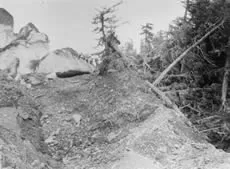Cryosphere glossary
pothole
a nearly vertical channel in ice that is formed by flowing water; usually found after a relatively flat section of glacier in a region of transverse crevasses; also called a moulin.
powder snow
a thin, dry snow surface which is composed of loose, fresh ice crystals.
prairie
a treeless grassy plain.
precipitation
(1) any of the forms of water particles, whether liquid or solid, that fall from the atmosphere and reach the ground; includes: rain, drizzle, snow, snow grains, snow pellets, diamond dust, hail, and ice pellets; see also acid precipitation (2) accumulated depth of rain, drizzle and the melted water content of frozen forms of precipitation.
precision
the degree of agreement between independent measurements of a single quantity obtained by applying a specific measurement procedure several times under prescribed conditions.
present weather
weather at a station at the time of observation.
pressure
a type of stress characterized by uniformity in all directions; in dynamics, it is that part of the stress tensor that is independent of viscosity and depends only upon the molecular motion appropriate to the local temperature and density; it is the negative of the mean of the three normal stresses, and is, therefore, a scalar quantity expressed in units of force per unit area; in meteorology, commonly used for atmospheric pressure.
pressure ice
a general term for floating ice which has been squeezed together and in places forced upwards; includes rafted ice, telescoped ice, hummocked ice and ridge ice.
pressure melting
melting that occurs in ice at temperatures colder than normal melting temperature because of added pressure.
pressure ridge
process that occurs when wind, ocean currents, and other forces push sea ice around into piles that rise and form small mountains above the level sea ice surface; ridges are initially thin and transparent with very sharp edges from blocks of ice piling up; also see keels.
pressure tendency
the character and amount of atmospheric pressure change for a three-hour or other specified period ending at the time of observation.
pressure-melting
lowering the melting point of ice by applying pressure.
prime meridian
the meridian (line of longitude) defined to be 0 degrees and passing through the Royal Greenwich Observatory in London; also known as the International Meridian or Greenwich Meridian; the Prime Meridian and the opposite 180th meridian (at 180 degrees longitude) separate the Eastern and Western Hemispheres.
pseudomorph
in geology, a mineral compound resulting from a process by which the primary mineral component is replaced by another, although the compound maintains constant appearance and dimensions.
psychrometer
an instrument used for measuring the water vapor content of the atmosphere; a type of hygrometer; it consists of two thermometers, one of which (the dry bulb) is an ordinary glass thermometer, while the other (wet bulb) has its bulb covered with a jacket of clean muslin which is saturated with distilled water prior to an observation; when the bulbs are suitably ventilated, they indicate the thermodynamic wet- and dry-bulb temperatures of the atmosphere; one variety is the assman psychrometer (a special form of aspiration psychrometer for which the ventilation is provided by a suction fan).
psychrometric tables
tables prepared from psychrometric data and used to obtain vapor pressure, relative humidity, and dew point from wet- and dry-bulb temperatures.
puddle
an accumulation of melt water on an ice surface, mainly due to melting snow, but in later stages also to the melting of ice; the initial stage consists of patches of slush.
push moraine
moraine built out ahead of an advancing glacier.
Image

The Columbia Glacier surged (advanced rapidly) earlier this century, part of it flowing into a forest. The push moraine in this photograph from 1914 shows Columbia Glacier literally pushing up trees and dirt as it advanced.
D.K. Handy, archived at the World Data Center for Glaciology, Boulder, CO
radar
RAdio Detection And Ranging was an original active microwave sensor that became widely operational with the onset of World War II.
radiation
(1) emission or transfer of energy in the form of electromagnetic waves (2) the process by which electromagnetic radiation is propagated through free space by virtue of joint undulatory variations in the electric and magnetic fields in space; this concept is to be distinguished from conduction and convection.